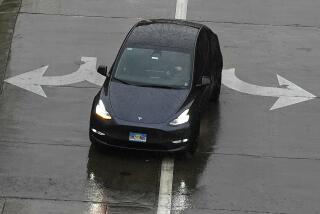$50,000 for a Jeep? Sticker shock helps explain why auto sales may stall out
Robert Loehr’s dealership is hanging in just fine, much like Fiat Chrysler Automobiles’ sales did last quarter. But just as investors doubt the U.S. car market can sustain near-record results for much longer, the Georgia retailer is apprehensive about a key issue: sticker shock.
“Prices are crazy on cars nowadays — all of them,” said Loehr, who sells Jeeps, Rams and other Fiat Chrysler models from a showroom northwest of Atlanta and has been in the business for 35 years. “They’re crazy to me, and I do it every single day, all day long.”
New Jeep Gladiators — the truck version of the rugged Wrangler model — can easily fetch $50,000 and are emblematic of a trend toward eye-popping prices that carmakers are commanding for the pickups and sport utility vehicles making up an ever-greater share of their sales. Even as manufacturers and lenders increasingly stretch out auto loan terms to more than seven years and subsidize interest rates with incentives, average monthly payments keep climbing.
With its 2020 Jeep Gladiator, Fiat Chrysler has delivered what amounts to a four-door Jeep Wrangler with a pickup truck stuck on its hind end.
Interest rates on auto loans dipped in September to 5.7%, the lowest this year, and the average term approached 70 months — nearly six years — according to market researcher Edmunds. Despite that, monthly payments rose from a year ago as the average transaction price on a new car exceeded $37,000 — a 14% jump from 2014.
Affordability could become more of a risk if the mounting concern that the American economy is headed for recession ends up panning out. Those fears drove the benchmark S&P 500 down more than 2% on Wednesday, to the lowest point since August. General Motors Co.’s stock price fell 3%, and Ford Motor Co.’s fell 4%.
The U.S. car market has probably reached the end of a great run, according to Brian Irwin, who leads the automotive and industrial practice for consulting firm Accenture. “It’s a step down from where we thought we would be a few months ago,” Irwin said in a phone interview. “I expect to see stronger incentives coming out.”
While Jeep’s Gladiator is drawing customers into Loehr’s dealership, many are balking at $800-a-month payments they end up being quoted. He’s been able to convert much of that foot traffic into sales of lower-priced Jeep models but still thinks automakers ought to do more banding together on engine development and parts-sharing to cut down costs and put a lid on prices.
GM, Ford and Fiat Chrysler’s quarterly results looked less dire than the big percentage drops that other carmakers reported Tuesday for September, in part because of fewer selling days in the month than a year ago. But on both days, contraction was a common theme, both for the automotive market and the broader manufacturing sector. A closely watched gauge of U.S. factory activity flashed the worst reading since the end of the last recession.
Third-quarter deliveries rose 6.3% for GM, a smaller increase than analysts expected, while Fiat Chrysler’s 0.1% slip and Ford’s 5.1% decline beat projections. Those figures weren’t enough to dispel the narrative set by rivals a day earlier, when Nissan Motor Co., Toyota Motor Corp. and Honda Motor Co. trotted out ugly numbers for last month.
Ford’s SUVs struggled in the third quarter, in part because of tight inventory of its redesigned Explorer SUV. But sales of its top-selling Escape crossover also dropped, falling 7.2%.
Despite the downward trend, Ford U.S. sales chief Mark LeNeve remains upbeat.
“The consumer, despite all the noise in the market, is still holding up remarkably well and kind of carrying the industry,” he said in a phone interview. “With the limited availability we had with Explorer and Escape because of the changeover, we’re actually pretty pleased with the quarter and we’re actually set up well for Q4.”
More to Read
Inside the business of entertainment
The Wide Shot brings you news, analysis and insights on everything from streaming wars to production — and what it all means for the future.
You may occasionally receive promotional content from the Los Angeles Times.










